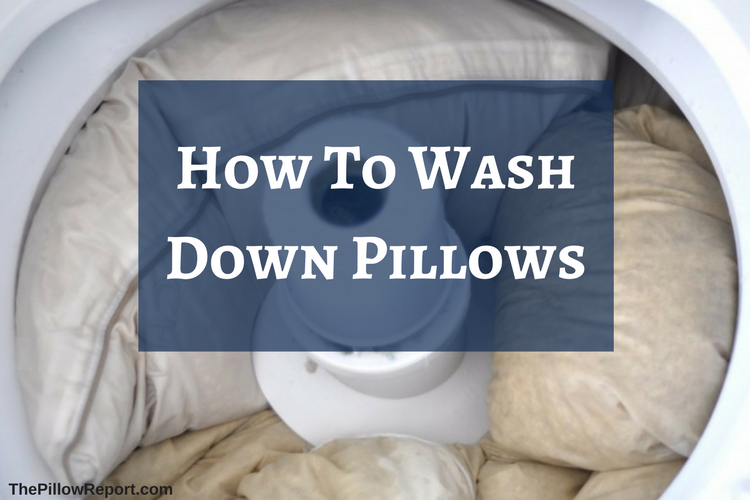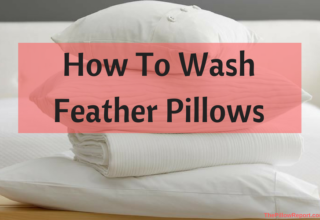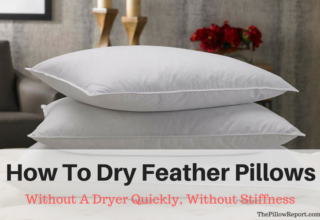You can only wash down pillows in a front-loading machine as a top-loading unit causes them to float and remain dry partially. Learning the ropes on how to wash down pillows in front load washer helps eliminate a litany of contaminants-including microbial pathogens, fungal spores, pollen, pet dander and other impurities.

Front-loading machines give a spick and span cleanup while leaving your beddings fresh and odorless. Washing down filling reinvigorates original fluffiness, natural support, and velvetiness.
Things To Consider | How To Wash Down Pillows In Front Load Washer
1. What You’ll Need To Wash
Two Pillows: Consider washing a pair of pillows to balance the load on the spin cycle.
Water Temperature: Use lukewarm water, hot liquid will cause damage to delicate feathers and shrink the fabric.
Spin Speed: Tweak to the fastest speed to evaporate as much moisture as possible.
Rinse: Add rinse cycle to flush out all the detergent.
To Non-chlorine bleach for whitening.
Check over the pillows for cracks and tears. Damaged ticking can open a new can of worms. You must mend before machine-washing.
Spot-treating stained parts on your bedding with all-natural or mild soap and warm water minimizes harsh cleanups. Use a toothbrush to slick down stains efficiently.
2. Washing in Front-Loader Steps
- Put the pillows into the machine. Do not immerse more than two pillows as nothing will get cleaned.
- Wash the pillows on a gentle or delicate cycle with warm water and add the detergent.
- Stay on the lookout and await the machine to fill, dispense the detergent, and toss the drum over a couple of times. Ensure the pillows get wholly saturated. When wringing wet, pause the unit and adjust a timer for 30 minutes.
- You can allow the machine to run independently. Run the pillows on a spin cycle to remove all the excess water.
3. Machine-Drying
Arm yourself with a pair of tennis balls enveloped in white socks to oscillate around with the pillow in the dryer and deter the explosion of sizable hunks. They also ensure filling does not bend out of shape.
Adjust the timer on your dryer on a moderate heat setting for 15 minutes, add the pair, tennis balls, and dryer sheet to prevent static and push start.
Unlike waterlogged comforters, pillows can dry out in a single cycle.
Scrutinize pillows with an eagle’s eye to ensure every corner has dried out thoroughly before encasing them in the pillowcase. Lurking moisture in the filling
4. Drying Concerns
Temperature-Avoid boiling water as it leads to shrinkage or wrinkling of fabric.
Drying duration-Wait with the patience of Job of the old, it can guzzle multiple cycles before you have them as dry as dust.
Lumps or Odor-Clumps or odor mean your pillow needs another drying cycle. You want it to stay kiln-dry, no traces of moisture to inhibit mold growth.
Dry-Test-Hand-fluff the padding before the cycles get completed. The pillows can eclipse dampness beneath the ticking. It’s safe to err by dedicating more drying time than vice versa.
In addition to tennis or dryer balls throw in a dryer sheet to make bedding as fresh as a daisy.
5. Wash Your Pillows Seasonally
Wash your pillows half-year or every three months as they tend to stockpile dirt, microbial invaders, allergens, and a litany of other impurities. Pillows collect dead skin cells, grime, and dander just like a mattress does.
Though pillowcases or protective cases catch some of the foreign particles, some micron-sized contaminants always find their way to the core. Accordingly, you’ll have to wash for a hypoallergenic surface.
6. Using Pillow Protectors to Lengthen Natural Life
Adding a pillow protector provides a buffer against unpleasant substances. It’s a prudent way to keep your bedding spotlessly clean without having to wash it frequently. Regular washing eats away natural oils that give down the ability to regain its fluffiness.
Waterproof pillowcases prevent moisture or liquids from creeping into the pillow, degrading the fill and emitting a pungent odor. Look for breathable and soft materials for the most comfortable sleep.
7. Pillow Cleanliness Affects Sleep & Health
Failure to wash your pillows for two years adds dead skin, dust mites, bed bugs, and their dropping to the fill weight. Sleepless nights traced back to dirty pillows by housekeeping mavens open the Pandora box of allergen hypersensitivity as well as chronic diseases due to deprived sleep.
The natural resilience of high-grade down endures washing in front-loading units for a pristine, healthier head-support.
Washing down and feathers on the odd occasion keep bedding cool for a freshened and luxurious sleep ambiance.
Unclean pillows carve out a breeding ground for microbes, pathogens, and dust mites, allergens stem from the droppings of these vermin.
8. Do’s & Don’ts
- For down and feather pillows, use only a front-loading washer as top-loading unit’s agitators in the middle destroy down
- Avoid abrasive detergents as they strip away oils that rekindle down after flexing out of shape
- For a subtle odor, you can add soothing essential oils such as lavender to the dryer balls
- Do not cut corners on the drying by using high heat as this also kills down and the fill clusters together into lumps
- More frequent machine-washing encourages lumps and eats away natural oils in down and flattens out the filling.
- Refresh pillows while washing by leaving them out in the sun
Final Verdict
Armed with this ken on how to wash down pillows in front load washer, you can do it seldom for a hygienic sleeping environment and prolong their natural life. You can prevent dirt and foreign substances from trickling down to the filling, use pillow covers as an extra layer of protection.
You can also spot clean stains with a branded product to avoid many washes. Drying acts as a crucial stage, failure to purge all H2O invites mold or mildew. Wash twice each year or thrice at the maximum for neat and health-giving bedding.
















